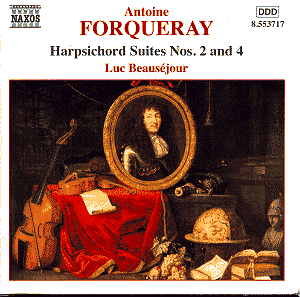The Forqueray family was well established in the hothouse
of musical and artistic talent that surrounded King Louis XIV of France
in his palace at Versailles near Paris. Antoine was considered one of
France’s foremost players of the viola de gamba, and his son, Jean-Baptiste-Antoine,
was an accomplished performer and music publisher.
The quality (and sheer quantity!) of music that emanated
from the Sun King’s palace established an 18th century French
keyboard style that influenced composers throughout Europe, and included
chamber music, operas, ballets and sacred works. Forqueray’s name does
not come readily to mind in the galaxy of composers that numbered Couperin,
Lully and Rameau among its stars. Nevertheless, Forqueray was valued
for his accomplishments, and survived to serve the King’s successor
Louis XV. One result of Louis XIV’s love of music was that he took the
unusual step, for that time of permitting court music to be published,
which preserved and disseminated many important works and collections.
It is possible that these Suites were heard at the
regular secular concerts held at Versailles, as were François
Couperin’s more celebrated Concerts Royeaux. The King had a somewhat
conventional musical taste, and liked short pieces. Most of the Suites
are sets of dances and descriptive pieces of a light, elegant nature,
the majority less than five minutes long, written to please and entertain
the court. No. 2 has five movements, No. 4 six. As was usual in that
period many are dedicated to other musicians or court personalities.
Forqueray’s five Suites were transcribed from viol
suites and preserve the original range of the viols, which places them
mainly in the middle and lower part of the harpsichord’s register, and
filled out with additional harmonies and embellishments. This makes
for a somewhat ‘beefy’ keyboard sound. Suite No.3, La Morangis où
la Plissay, a Chaconne by Forqueray’s son, Jean-Baptiste-Antoine,
ends the third published Suite. Jean-Baptiste published all five Suites
arranged from his father’s works in two versions, one for viols and
the other for harpsichord.
Though reflecting the much-admired ‘new’ French keyboard
style, the music is rather strait-laced for its time and place, and
less colourful than Couperin’s and Rameau’s sparkling vignettes. It
receives a winningly enthusiastic performance from Luc Beauséjour
on the forthright Yves Beaupré harpsichord after Hemsch and Blanchet
used for this performance. The recording acoustic has more echo than
is desirable for perfect clarity. The inclusion of movements from Suites
1, 3 and 5 was probably necessary to ensure completeness, and does not
sound incongruous.
Roy Brewer
